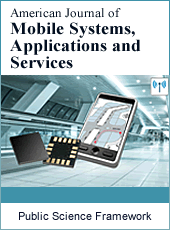American Journal of Mobile Systems, Applications and Services
Articles Information
American Journal of Mobile Systems, Applications and Services, Vol.1, No.1, Aug. 2015, Pub. Date: Jul. 15, 2015
Adjusting Blocking Probability of Handoff Calls in Cellular Mobile Communication
Pages: 6-11 Views: 2970 Downloads: 2075
[01]
G. R. Ahmed Jamal, Department of Electrical and Electronic Engineering, University of Asia Pacific, Dhaka, Bangladesh.
[02]
Tareq U. Ahmed, Department of Electrical and Electronic Engineering, University of Asia Pacific, Dhaka, Bangladesh.
[03]
N. Shahadat, Department of Electrical and Electronic Engineering, University of Asia Pacific, Dhaka, Bangladesh.
[04]
M. F. Islam, Department of Electrical and Electronic Engineering, University of Asia Pacific, Dhaka, Bangladesh.
[05]
Marium B., Department of Electrical and Electronic Engineering, University of Asia Pacific, Dhaka, Bangladesh.
The problem of handoff calls management in cellular mobile communication is discussed. A simple but efficient design of a cellular network for a small area is proposed so as to keep blocking probability of handoff calls (BH) below a pre-defined margin. The non-prioritized scheme of managing handoff calls for a single traffic system is used here to find the blocking probability. Xie and Kuek’s traffic model is used to predict the teletraffic parameters. The value of BH is calculated using MATLAB for different values of parameters so as to find the minimum number of channels requiredso as to keep BH below 5%.
Cellular Mobile, Handoff Call, Blocking Probability, Traffic Model, Channel
[01]
S. R. Subramanya, B. K. Yi, “Mobile Communications-an Overview”, IEEE Potentials, Vol. 24, Issue 5, pp. 36 – 40, 2005.
[02]
J. Khan, “Handover Management in GSM Cellular System”, International Journal of Computer Applications (IJCA), Vol. 8, Number 12, Article-4, 2010.
[03]
D. Hong and S.S. Rappaport, “Traffic Model and Performance Analysis for Cellular Mobile Radio Telephone Systems with Prioritized and Non-prioritized Handoff Procedures”, IEEE Trans. Veh. Tech., Vol. 35, Issue: 3, pp.77 – 92, 1986.
[04]
Q. A. Zeng and D. P. Agrawal, “Handoff in Wireless Mobile Networks”,Handbook of Wireless Networks and Mobile Computing, John Wiley & Sons Inc. New York, I. Stojmenovic (Editor), pp. 1 – 25, 2002.
[05]
A. N. Khan, X. Sha, W. Anwar and A. Khan, “Performance Analysis of Prioritized and Non-prioritized Handoff Call Queuing Schemes in Mobile Cellular Networks”Proceedings of the 7th International Conference on Frontiers of Information Technology, Pakistan, 2009.
[06]
M. Gudmundson, “Analysis of Handover Algorithms”, Proc. of IEEE VTC ’91, pp. 537–542, May 1991.
[07]
V. Kapoor, G. Edwards and R. Sankar, “Handoff Criteria for Personal Communication Networks”, Proc. of IEEE ICC ’94, pp. 1297–1301, May 1994.
[08]
T. S. Rappaport, “Wireless Communications: Principles and Practice”, Prentice Hall, 2nd Edn, pp. 63, 2002.
[09]
R. Steele and M. Nofal, “Teletraffic Performance of Microcellular Personal Comm. Networks”,IEEE Proc.-I, Vol. 139, No. 4, August 1992.
[10]
H. Xie and S. Kuek, “Priority Handoff Analysis”, Proc. IEEE VTC ’93, pp. 855–858, 1993.
[11]
Q. A. Zeng, K. Mukumoto, and A. Fukuda, “Performance Analysis of Mobile Cellular Radio Systems with Two-level Priority Reservation Handoff Procedure”, IEICE Trans. Commun., Vol. E80-B, No. 4, pp. 598–604, 1997

ISSN Print: 2471-7282
ISSN Online: 2471-7290
Current Issue:
Vol. 5, Issue 1, March Submit a Manuscript Join Editorial Board Join Reviewer Team
ISSN Online: 2471-7290
Current Issue:
Vol. 5, Issue 1, March Submit a Manuscript Join Editorial Board Join Reviewer Team
| About This Journal |
| All Issues |
| Open Access |
| Indexing |
| Payment Information |
| Author Guidelines |
| Review Process |
| Publication Ethics |
| Editorial Board |
| Peer Reviewers |


